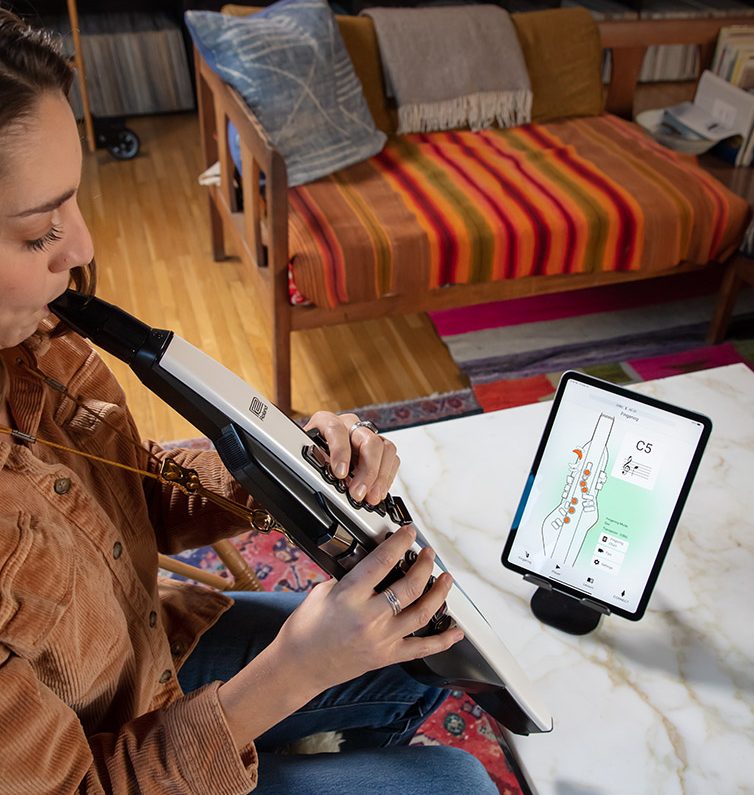In many cases, when you start to learn to play a new instrument, knowing how to play the instrument isn’t the only skill you need. You also need to learn to read music. Reading music can seem complicated, but it is a skill that, once acquired, opens up new doors and possibilities. You can expand your repertoire and gain access to musical opportunities otherwise out of reach. Once you master saxophone fingerings with Aerophone, you can choose one of two routes: continue playing by ear or learn to read music.
Begin with the Basics
If you search “how to read music” online, you’ll find plenty of great articles breaking down everything you need to know to tackle this skill. But if you need more guidance and hands-on practice, here’s how to start.
Download the Aerophone App
Download the free Aerophone Lesson app for iOS or Android and start playing immediately. The app will help familiarize you with your instrument through practice songs and accuracy scoring. You can also play along with songs on your device through the app.
The app connects to your Aerophone via Bluetooth and has an interactive display to check your fingering. It includes tutorial videos to help you get started and eleven play-along songs to make practicing fun.
Use the Transposition Feature
There are 12 different keys (or scales) that you can play in, but with the Aerophone transposition feature, you can get started with just one. Each key requires learning a different set of fingerings, so you can keep things simple by learning just one scale and then using the transposition feature to change the instrument’s key.
Learn by Ear
Many musicians start out playing by ear and gradually learn to read music; the saxophone is no exception. And whether you can read music or not, being able to play by ear is an essential skill.
Playing by ear is learning to play what you hear. Having this skill means that you can play and fit into different musical settings whether or not you have a sheet of music in front of you. You can develop ear training by listening to music and emulating what you hear on your instrument, note by note.
MIDI to Notation
You can also use the Aerophone to notate music and see how what you’re playing connects to what you’re seeing on a sheet of music. Simply plug your Aerophone into your computer via USB and open up your favorite music notation software like Sibelius or Finale. Select the Aerophone as the MIDI input device from the settings and start recording MIDI data into your software to see how your playing translates to the page.
"You can also use the Aerophone to notate music and see how what you’re playing connects to what you’re seeing on a sheet of music."
Find Lessons Online
Today, you can find an endless stream of free online lessons for saxophone. And because the fingering system is the same, those lessons are just as applicable for the Aerophone as for its acoustic counterpart.
Take to YouTube and search “saxophone lessons” or “saxophone tutorials” to find free content. As you get more advanced, you can extend your searches to “how to play [song] on saxophone” or “beginning jazz solo lesson.”
Follow Tradition
If you’re a more visual learner, you may find the more traditional learning methods best. Try instructional books. There are many fantastic options, whether you want to start with a method book or something else. You can find books that help you fine-tune a wide range of skills, from improving your tone to mastering scales, sight-reading, and much more.
Connect with a Teacher
There’s nothing like a superb music instructor. They offer learners one-on-one instruction with personalized feedback, direction, and instruction. A good teacher will motivate learners to practice consistently, and their experience can be an incredible resource for any learner. Plus, a teacher can catch bad habits before they become ingrained and offer solutions to set you up for success.
"A teacher can catch bad habits before they become ingrained and offer solutions to set you up for success."
The Well-Rounded Musican
There’s no one right way to go about learning an instrument. What may work for one player may not work for another. And to become a well-rounded musician, it’s essential to learn from a variety of sources. Combining a few of the above suggestions will keep you interested and offer a more complete introduction to your instrument.
And with the Roland Aerophone, it’s never been easier to start playing. Using a pair of headphones and a set of batteries, you can play anywhere at any time. The Aerophone’s portability and connectivity make it the perfect practice and performance instrument for any setting.
Helping players learn to read music is only one of the many great things about the Aerophone. Explore how easy it is to care for this convenient, low-maintenance digital wind instrument.







